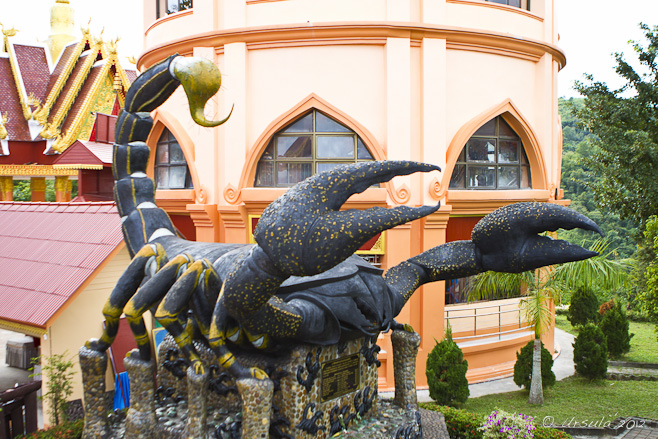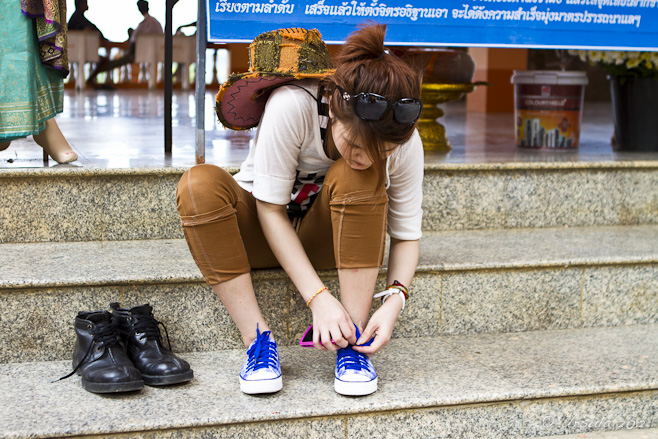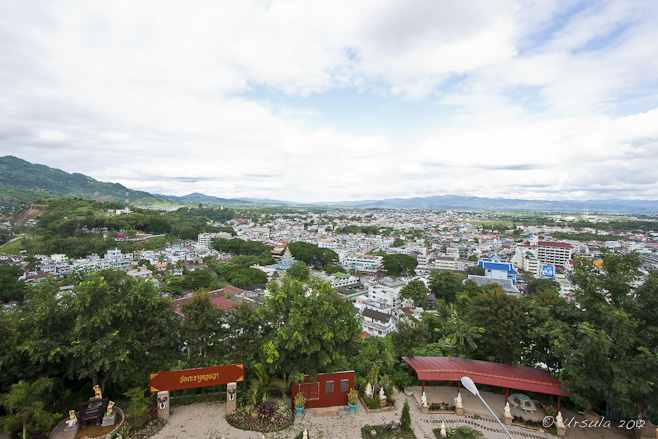The temples of Thailand are extraordinarily diverse; nowhere is this more true than in the north. From the black and white expressions of modern Thai artists (Two Artists: Contrasting Visions), to Golden Buddhas with their backs to casinos and drug trade (Golden Ratios and the Sublime); I’ve said before that Thai temples are not all the same (e.g.: Temples and Gods)!
As if to really emphasise this point, on the same day as we gave alms to the horseback-monks in the morning (Mounted Monks), we visited a temple paying tribute to scorpions in the afternoon.

Part of Wat Phra That Doi Wao, this giant scorpion faces Tachileik in Myanmar.
I don’t know why this scorpion sits here, or what it represents. The plaque on the front lists the moneys donated to the building, but gives no indication as to the purpose. Our guide (whose English wasn’t great) shrugged, and said something about “maybe” there were a lot of scorpions here before. One on-line wag suggests it might be a tribute to the movie: “The Scorpion King” while others think it’s a way for Thais to thumb their noses at Myanmar, reminding the Burmese of border conflicts that the Thais have won in the past.
Whatever the purpose, the scorpion sits between two buildings, both of which afford great views over Mae Sai, across the Mekong, and of Tachileik and the rest Myanmar.

Before you climb to the top of Wat Phra That Doi Wao, you need to remove your shoes.

View from Wao Mountain over Mae Sai and Tachilek to the hills of Myanmar; the Mekong runs a diagonal - mostly hidden by the buildings.

This Burmese couple has come to the Scorpion Temple for the purpose of having their wedding pictures taken.
The colourful paint on the surrounding buildings give the whole area a carnival-like atmosphere, and I found it hard to take the complex seriously as a temple. Clearly, however, this was not a problem for the visiting monks or other faithful who came to get blessings from the abbott.

Our guide stops for blessings from the abbot.

Monks come to discuss issues or problems with the abbot.

Shrine on the Wat Phra That Doi Wao complex.

Temples are always expanding and in need of work. "He's doing a good job," this worker tells me.
Our next temple that day was another complete contrast: a traditional temple in a quiet suburb of Chiang Saen, up a street so steep and narrow our van failed and we had to get out and walk. According to legend, Wat Phra That Pu Khao was built in 759 AD. According to architectural historians, however, it was more likely constructed in the 13 hundreds. Either way, it is old and understated.

Seated bronze Buddha, Wat Phra That Pu Khao

Paying respects to the Buddha

Stone Devī : Wat Phra That Pu Khao
Wat Phra That Pha Ngao, at the southern end of Chiang Saen, climbs up another hill, providing more views over the Mekong; this time over Laos. Another temple reputedly started as early as 462 AD, the complex extends over 22.88 hectares.
We started at the top of the hill: at the much newer bell-shaped chedi.

Phra Bharommathat Buddhanamit Chedi sits at the top of the whole Wat Phra That Pha Ngao complex.

The view from the Phra Bharommathat Buddhanamit Chedi over the Mae Kham and Mekong.

The Ubosot (Ordination Hall) at Wat Phra That Pha Ngao is an elaborate golden teak chapel.

The Chapel is set in beautiful grounds which must take a lot of people-hours to maintain.

The Golden Teak Chapel, Wat Phra That Pha Ngao.

Theravada Buddhist Nun, Wat Phra That Pha Ngao

When building the new hall or wihan, they found ancient temple ruins...

... of an old brick Buddha, which they incorporated into the new building.

"- Knees down beside the fortune elephant. - Clear your mind totally and make a wish."

The ancient Pha Ngao Pagoda.
The last Chiang Saen temple we visited was Wat Chedi Luang, started in 1291 in the time of the Lanna kings.

Golden Buddha, Wat Chedi Luang.
 Certainly, common threads through the various temples, but each with its own distinctive style.
Certainly, common threads through the various temples, but each with its own distinctive style.
As the Thais say: “Same, Same… but Different!”
Photos: 30 October 2011


























.png)


very interesting this scorpion temple Ursula. Nice all the peoples around. Greetings Dietmut
Cheers, Dietmut!
wonderful as always…happy travels
Always happy for you to join me, Signe. 🙂
Very lovely pictures! Happy travels!